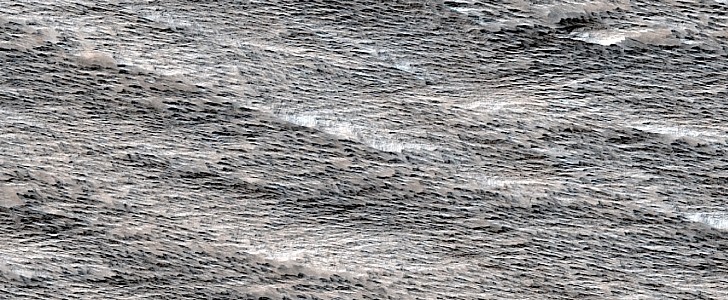Modern day television screens, or screens in general for that matter, are so well made that they rarely return an out-of-focus picture. They’re so good at their job that, for instance, one famous TV series intro from decades ago would make no sense today.
The Outer Limits, a series that ran from 1963 to 1965 and then again from 1995 to 2002, opened with a voice saying “There is nothing wrong with your television set. Do not attempt to adjust the picture. We are controlling transmission…” and so on and so forth. The words were backed by fuzzy images that, what do you know, looked pretty much like what you’re seeing in the main photo of this piece.
In fact, The Outer Limits vibes are so potent with this one that even scientists from NASA and the University of Arizona titled it “Do Not Adjust Your Television Set.”
The image was taken in October last year from 271 km (168 miles) above the Martian surface by the HiRISE camera, and it shows a portion of the Medusae Fossae Formation on the planet. Well, it doesn’t show much of anything, except for what looks like static.
But that (static) is not actually what we’re seeing. According to the people looking at Mars for a living, the image shows a fluffy powder, whose origin is not detailed, “carved by the wind into odd patterns.”
It is those patterns that make the surface look fuzzy to the lens of the HiRISE camera, and there’s even proof of that. If you look closely (click main photo to enlarge) in the upper right corner, you’ll see a perfectly contoured impact crater, a sign “the camera is working just fine.”
As for the Medusae Fossae Formation, that’s a (probably) volcanic geological area of the planet made up of soft deposits. The region spans 5,000 km (3,107 miles) right on the planet’s equator.
In fact, The Outer Limits vibes are so potent with this one that even scientists from NASA and the University of Arizona titled it “Do Not Adjust Your Television Set.”
The image was taken in October last year from 271 km (168 miles) above the Martian surface by the HiRISE camera, and it shows a portion of the Medusae Fossae Formation on the planet. Well, it doesn’t show much of anything, except for what looks like static.
But that (static) is not actually what we’re seeing. According to the people looking at Mars for a living, the image shows a fluffy powder, whose origin is not detailed, “carved by the wind into odd patterns.”
It is those patterns that make the surface look fuzzy to the lens of the HiRISE camera, and there’s even proof of that. If you look closely (click main photo to enlarge) in the upper right corner, you’ll see a perfectly contoured impact crater, a sign “the camera is working just fine.”
As for the Medusae Fossae Formation, that’s a (probably) volcanic geological area of the planet made up of soft deposits. The region spans 5,000 km (3,107 miles) right on the planet’s equator.






